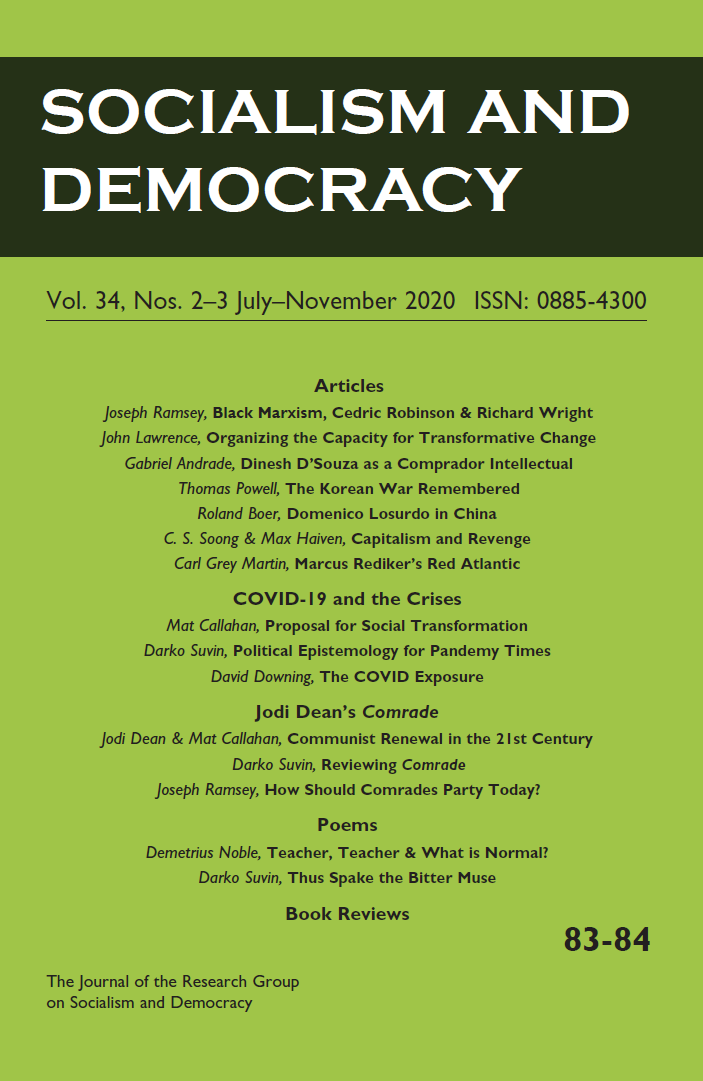Jedediah Purdy, This Land is Our Land: The Struggle for a New Commonwealth. (Princeton and Oxford: Princeton University Press, 2019) 164 pages, $19.95.
Jedediah Purdy builds his central argument around Aziz Rana’s thesis that the American ideal of freedom has two incompatible faces. America “began as both a world-historical land grab and a world-historical experiment in republican self-rule” (ix). Power in the post-Revolutionary republic would no longer be anchored in inherited right, as it had been in the pre-Revolutionary Era and as it remained in Europe. In the ‘new’ world’s first republic, power would be linked to legally sanctioned ownership of land, and thereafter divide “those who own the places where they live [from] those who own another’s place” (x).
Echoing his legal-professional interest in undermining the dominant technocratic, (neo)liberal Law and Economics movement by replacing it with a more democratic Law and Political Economy approach to theorizing the law, Purdy recognizes that no such project can succeed without a shared vision for “an economy and ecology of common care” (xxv). The book’s purpose is to build Purdy’s case that the belief in freedom for ‘insiders’, always dependent on the subjection of ‘outsiders’, is politically offensive and ecologically unsustainable. He elaborates another idea of freedom: Egalitarian distribution of the capacities needed to guarantee common-wealth. In the context of massive upward redistribution of wealth and income and the global climate emergency, Purdy sees the task of defending this idea as requiring significant partisan resourcefulness if it is going to succeed against the insiders-only ideal. Implicitly, Purdy is arguing that Law and Economics is merely the jurisprudence of the winner. Reacting to the twin pressures of inequality and ecological crisis, its advocates are using that movement’s Holy Grail, private property rights, to barricade the winners off from their obligations to fellow citizens.
Early on, Purdy neatly dismantles the mainstream “pastoral centrist view”, which sees “the idea of Americans being one another’s enemies [a]s a fever symptom caused by a disease called polarization” (1). In his more realistic view, civic enmity arises from who you are and where you live. For some, the police are protectors, for others a dangerous menace. For some, markets facilitate possibility and liberation, for others impossibility and subjection. The things that bind people are the same things that separate them, because “[a]ny arrangement for living together has both sides, and they have to be understood together. How do people come to be one another’s problems, threats, burdens? How do we become one another’s helpers, protectors, friends?” (3). I find Purdy’s normative framing of the problem of civic enmity in such conciliatory terms problematic. I will return to this point later.
With this normative lens, he analyses the 2017 presidential orders to remove significant acreage of federal land from protection in the Bears’ Ears and Grand Staircase-Escalante national monuments in Utah, protesters riding four-wheeled motorbikes over public lands in the West, efforts to defend Confederate statues in the South, and the phony war on coal. Purdy urges readers to see these not as efforts to assert local against national power but as local bids for power by some over others. He rejects both what he sees as pastoral centrism and such reactionary chauvinism on grounds that “[d]emocratic politics, in potential, creates a common space where equals have to decide the terms of their coexistence [and] can survive not as a morality play, but only as a project” (20).
Purdy adds his own voice to scholars such as Arlie Hochschild, Eliza Griswold, Pauli Murray, Phil Neel, and others. He tries to understand why so many working-class Americans, especially those who self-identify as white, straight, and God-fearing, are willing “to suffer at the hands of the institutions [one’s] people identify with, and to forgive them nearly anything out of loyalty”, and to serve as “the market[’s] own private patriots” (38). He locates the problem in a logical response to powerlessness: the wild oscillation between actual or latent violence and paranoiac withdrawal. A most penetrating insight on this point is an outline of what Purdy calls “country culture”, which binds straight, God-fearing, working-class whites with the majority of “white Trump voters, who are mostly exurban and middle class but are drawn to [country culture’s] weird mix of western kitsch and southern threat” (46).
Purdy reflects on the 2016 presidential election in a nuanced way that is well worth considering. Recalling Thoreau’s 1854 reflections on Massachusetts’ enforcement of the Fugitive Slave Act, Purdy similarly mourns, not only for having “lost a country” but, apropos his commitment to democracy-as-project, for the fact that what was lost was not “‘already great’ [but] with its extremes of wealth, poverty, and insecurity, its racial resentments and racial terror”, incomplete (60). For consolation, Purdy turns to Marx. He finds that when one looks at land, what one sees is “the nonhuman body of the species, in which the history of economic and political life is written as vividly as laws” (66). Prompted by this insight, he reaches further back and farther afield, to Lucretius, a move which echoes recent efforts to revive a kind of Epicurean realism by philosophers such as Raymond Geuss. In contrast with the perhaps more well-known Stoics, Sophists, and Cynics, what Epicureans such as Lucretius reveal to us is a universe that is indifferent to our moral and ethical beliefs. In modern terms, Lucretius describes a ‘normativity’ that seeks ways of reconciling one’s self to the essential meaninglessness of life and nature. Efforts to ascribe moral or ethical meaning to an indifferent universe can only lead to fear, which leads to destructive self-pity, resentfulness, and anger. And which cannot be assuaged by ever-more fervently believing that essentially random natural events have moral significance.
Purdy revisits Lucretius in order to reveal how that response—fear—is prioritized by Trump-supporting country culturalists and, since 2016, also liberals. This is a new and very productive use of canonical work in political theory. As have reactionary movements throughout history, what country culture does today is angrily and incoherently demand that essentially random events are morally significant: ‘God hates fags’. Yet, the historical tables have also been turned. Today, “liberal rationalists [i.e. pastoral centrists] also tell a story about the moral … meaning of the weather” (72). For Purdy, liberals rely on the undisputable truth of climate science, not to demonstrate the fact that time for action is running out, but to show that they are right and that country culturalists and other Trumpists should be persuaded to respond ‘rationally’. This misuse of scientific fact as moral trump card paves the way for “hierarchical and nationalist conservatives [to] deploy the little knives …” of undisciplined skepticism (72). The Right has simply “figured out that … the fact of being on one planet … does not mean we are in this together” (73).
Later, Purdy considers the global climate emergency. Even though climate science begs the question “‘What sort of world shall we make?’”, it is “no one’s job to see the whole” (85) or to take responsibility for it. Purdy acidly disposes with the technocratic ideology of “the hack” as nothing more than “pursuing system-level agency [in] the absence of political capacity to act at the scale of the system” (88). Moreover, the pastoral centrist appeal to humanity is pointless, and obscures that “it was the collective power of some—not all—human beings that got us into this: power over resources … over one another” (96). Noting something that is by now a well-rehearsed lament, Purdy finds that with the destruction of organized labor since the 1970s—especially that most threatening faction within the labor movement, which sought to link working-class interests to environmental protections by expanding the democratic project—radicals and reformers have been bereft of agency and an agent.
In the weakest section of the book, the new agent is identified. This said, I do not disagree with Purdy’s identification of the environmental justice movement as an agent of ecological democracy but rather, with the conclusions that he draws from his historical analysis of that movement’s effectiveness. Building on Robert Gottlieb’s seminal Forcing the Spring, he rejects the early American environmental movement as anything but emancipatory. He argues that key figures such as John Muir, Gifford Pinchot, and Madison Grant were effectively, white-supremacist eugenicists. Rather, it has been and remains grassroots activists seeking self-sufficiency, dissolving racial distinctions among working-class Americans, and fighting for industrial, urban, and food safety, who have linked the democratic impulse to ‘the environment’. It took decades of such struggle to convince the mainstream environmental movement of its folly. For Purdy, it was the emergent environmental justice movement that made possible the achievements of the 1960s and 1970s: the Clean Air Act, the Clean Water Act, and the Environmental Protection Agency.
It is here that I am most troubled by Purdy’s argument. In short, he does not take his realism far enough. He sees these achievements as the political products of a newly emergent class and racial justice-oriented moral success, the post-1960s environmental justice movement. Rather, what Gottlieb shows is that these were the products of a Nixon administration that, in consultation “with the corporate point of view”, 1 was bent on achieving two very different goals. The first was to drive a wedge between working-class and ‘new social’ movements: anti-war, Civil Rights, environmental, and feminist. As Purdy notes, the integrated United Auto Workers were major funders of the first Earth Day, and the Miners for Democracy insurgency in the United Mineworkers of America struck for workplace regulations and environmental protections in 1969. The second goal was to defend economic growth from regulation in the name of the environment.
Purdy’s emphasis on the achievements rather than the constraints under which the post-1960s environmental movement acted weakens his analysis. He seems to be looking for moral triumph, the reconciliation of the universe with the moral demand for justice, a very un-Lucretian move if I might put it that way. Rather, this ‘success’ was also a failure. The radical democratic movements were squashed and, as Gottlieb recognizes, by the late 1970s many formerly radical environmentalists had given up on the task of dismantling the fossil fuel-driven military-industrial complex and moved ‘inside the beltway’ as green technocrats. In a realist lens, the lesson is not as Purdy would have it, to become “one another’s helpers, protectors, friends” (3), but to force one’s opponents to back down. This is exactly what the advocates of country culture are daring the radical and reformist left to do, betting that pastoral centrism is the order of the day among liberals, social-democrats, socialists, and the like. While Purdy effectively shows the weakness of such pastoral centrist moralizing, he fails to recognize that there remains a hint of the pulpit in his own pronouncements. This analytic shortcoming aside, overall Purdy’s book makes an important contribution to contemporary democratic thought.
Andy Scerri
Department of Political Science & International Studies, Virginia Tech
ajscerri@vt.edu
1. See Gottlieb R. (2005) Forcing the Spring: The Transformation of the American Environmental Movement, Washington DC: Island Press, p. 153; Also, Luke, Timothy W. (1999) Capitalism, Democracy and Ecology: Departing from Marx, Urbana: University of Illinois Press.; Hunold, Christian and John S. Dryzek (2002) “Green Political Theory and the State: Context is Everything”. Global Environmental Politics 2: 17-39.

